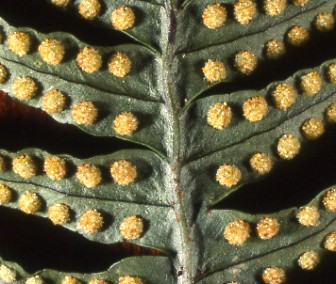
| (Link to a general discussion of the alternation of generations in all plants.) |
Sori form on the fronds. Each contains many sporangia mounted on stalks.
Within each sporangium, the spore mother cells undergo meiosis producing four haploid spores each.
When the humidity drops, The photo shows the sori on the underside of the leaflets of Polystichum acrostichoides, the Christmas fern.
The photo shows the sori on the underside of the leaflets of Polystichum acrostichoides, the Christmas fern.
If moisture is plentiful, the sperm swim to archegonia — usually on another prothallus because the two kinds of sex organs generally do not mature at the same time on a single prothallus.
Another method for promoting cross-fertilization: The first spores to germinate develop into prothallia with archegonia. These prothallia secrete a gibberellin into their surroundings. This is absorbed by younger prothallia and causes them to produce antheridia exclusively.
Fertilization restores the diploid number and begins a new sporophyte generation.
The embryo sporophyte develops a foot that penetrates the tissue of the prothallus and enables the sporophyte to secure nourishment until it becomes self-sufficient.
Although it is tiny, the haploid fern prothallus is a fully-independent, autotrophic plant.
| Welcome&Next Search |